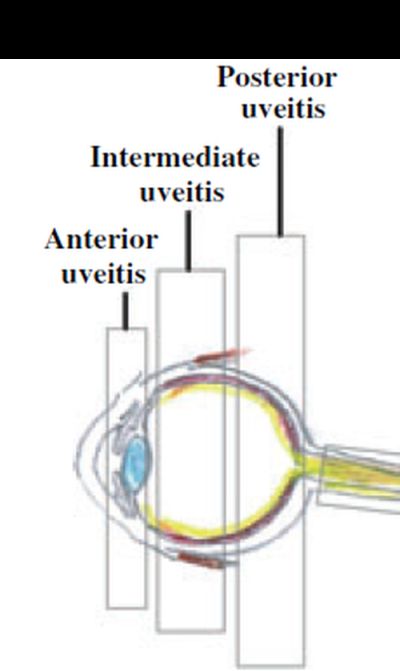HLA-B27 and uveitis
Introduction
Patients with AS are prone to acute anterior uveitis (AAU). However, most cases of AAU do not have AS but many of them carry the HLA-B27 gene. If the HLA-B27 gene had a motto, it would be the same as that of the Olympic movement, whose motto is "faster, higher, stronger". Unlike the Olympic motto, the HLA-B27 gene is also associated with stamina since attacks of eye inflammation tend to keep recurring. The page explains HLA-B27 in relationship to eye disease.
Site specificity of uveitis
HLA-B27 related eye disease (whether in AS or in patients without AS) is nearly always an anterior uveitis. This is where there are lots of small moving parts like a camera lens and shutters. We believe that the immune system to tissue stressing at that site may trigger disease.

|
| HLA-B27 related diseases lead to inflammation at the front of the eye which is known as anterior uveitis. Posterior or intermediate uveitis is hardly ever a feature of HLA-B27 related disease. We think that this is due to "tissue specific" factors relating to movement of small entheses that triggers disease. |

|
| This is a drawing of the iris or a view of the pupil of the eye from the front This structure rapidly opens and closes many thousands of times per day to adjust focus and the amount of light that enters the eye. As shown on the image it has numerous small vessels. Movement related microscopic damage to this structure and related muscle attachments could be key in triggering HLA-B27 related disease. |
HLA-B27 and the Eye
If somebody gets an attack of anterior uveitis, it is much more likely to recur if they are HLA-B27 positive. Put another way, an attack of anterior uveitis is more likely to be a one-off event in HLA-B27 negative people [1,2,3].
If somebody gets an attack of anterior uveitis on one side it is much more likely to flip-flop to the other side if they are HLA-B27 positive.
In HLA-B27 positive cases, the degree of inflammation is also more severe than in HLA-B27 negative cases.
In patients with anterior uveitis without AS, the presence of HLA-B27 is more often associated with progressive vision loss. This is a consequence of the more severe inflammation that is seen in the HLA-B27 positive group.
Enthesis and HLA-B27
Patients with AS and uveitis may have an abnormal response to tissue mechanical stress. This is shared between the moving parts in the front of the eye and the skeleton.
Attacks in subjects with AS are often self-limiting and often settle with topical steroids. Each attack is usually on one side only. Given that both eyes have an identical structure this suggests that some random event takes place in the leading to disease. This could likely be microdamage related to movement of the anterior eye muscles and ligaments but this is not proven.
What is HLA-B27 doing that leads to eye inflammation?
We don't know the answer to this question but the extremely delicate and intricate anatomy of the moving parts of the eye set the scene for inflammation.
Given that uveitis may come on many years after a diagnosis of AS it is quite possible that the unknown eye tissue subject to the immune attack, could be completely different to that in the skeleton which is also unknown.
It is possible that the immune attack is against structural components of a dead germ that gets deposited in the eye.
Finally the initial attack may be against structural components of a germ which is shared with human eye tissue. This "molecular mimicry" could lead to disease.
References


